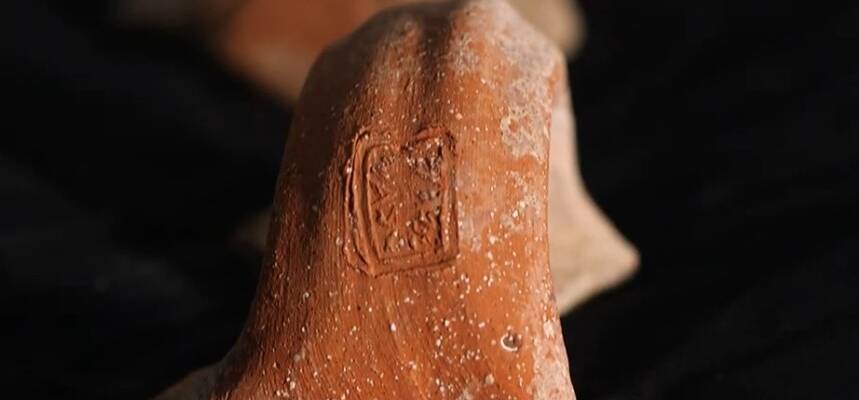‘It is very moving to encounter messages from high-ranking officials in the Judahite administration from some 2,700 years ago,’ says Israeli Heritage Minister.
For the first time in Jerusalem, archeological excavation have found evidence showing the impact of the Biblical-era Assyrian king Sennacherib’s military campaign on the economy of the Kingdom of Judah.
During Israel Antiquities Authority excavations funded by the Israel Land Authority prior to the construction of the new Mordot Arnona neighborhood in the capital, revealed changes in the Judahite administration from the days of King Hezekiah in wake of the Assyrian military campaign and aftermath.
Until now, evidence of the campaign which followed Judah’s rebellion was known from the Judean Lowlands (Judean Shephelah).
From the recent excavations, a picture emerges indicating that the original Judahite administrative structure that existed on this site was completely destroyed.
“We discovered remains of a significant royal administrative center from the days of King Hezekiah, and perhaps even from the reign of his father, King Ahaz,” say Neria Sapir, Natan Ben-Ari and Benyamin Storchan, excavation directors on behalf of the Israel Antiquities Authority.
“The center functioned in the last third of the 8th century BCE but was destroyed down to its foundations and buried under a massive heap of stones.”
“The stone pile formed a platform upon which subsequent structure was erected, holding a commanding view of all the agricultural areas to the east of the Armon Ha-Natziv – Ramat Raḥel ridge, and could be seen from afar. Large building stones originating from the early structure were deliberately incorporated into the heap.”
“We interpret these dramatic changes as a statement by the Assyrian imperial government, intended to convey a political-diplomatic message to the surrounding region and make it clear ‘who is really in charge’ by overhauling the administrative structure and its function.”
“As the Assyrians were still interested in the agricultural produce and taxes Judah could provide, they did allow for the existence of an independent Judahite administration, buy rather intensified its heavy economic demands.”
The administrative activity of Judah included the concentration and management of the agricultural produce farmers used to pay taxes to the kingdom.
The produce was transported and delivered in large ceramic storage jars – perhaps also stored here as a reserve for times of scarcity. In addition, wine, and possibly olive oil, were produced here in the Morodot Arnona neighborhood.
Evidence of the changes in the Judahite administration after Sennacherib’s military campaign found in Morodot Arnona include the discovery of an array of stamp impression jar handles.
The long chronology of the seal assemblage portray Mordot Arnona’s significance and continuity across changing administrative stages.
Dating from the 8th century BCE onwards, dozens of “lmlk” – “(belonging) to the king” stamp impressions were discovered here, as well as 17 handles with ‘private’ names written in Hebrew script.
Among the names on the ‘private’ jar-handle stamps are Menachem Yubna, Peqach Tavra, Tzophen Azaryahu, and others.
Who were these people? Were they the elite estate land owners who were the drivers of the kingdom’s economy; or, were perhaps senior Judahite officials?
The findings from Arnona, which will be published together with a team of researchers from Tel Aviv University led by Prof. Oded Lipschits, strengthen the hypothesis that the ‘private’ stamp impressions are part of a short-lived administrative system, operating prior to Sennacherib’s military campaign – as part of the Kingdom of Judah’s preparations, led by King Hezekiah, to rebel against Assyria, at which time taxation to the Assyrian Empire ceased.
From the beginning of the 7th century BCE onward, the lmlk stamp impressions differ from the earlier types and mark the return of Assyrian taxation in the aftermath of Sennaherib’s campaign.
According to the Minister of Heritage, Rabbi Amichai Eliyahu, “It is very moving to encounter messages from high-ranking officials in the Judahite administration from some 2,700 years ago. The fascinating discovery by the Israel Antiquities Authority tells the millennia-long story of the Jewish people, who—despite crises and very difficult periods—have always known how to rise again, rebuild, and thrive.”
ANTISEMITISM IS SURGING, THREATENING JEWISH LIVES!
Join Six Million United Against Antisemitism!
We stand united against antisemitism and pledge to fight hatred and violence against the Jewish people and its institutions around the world.
Sign the petition - Declare 'Never Again is Now'!























